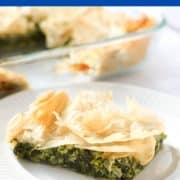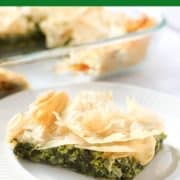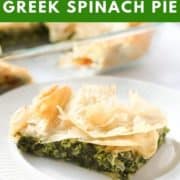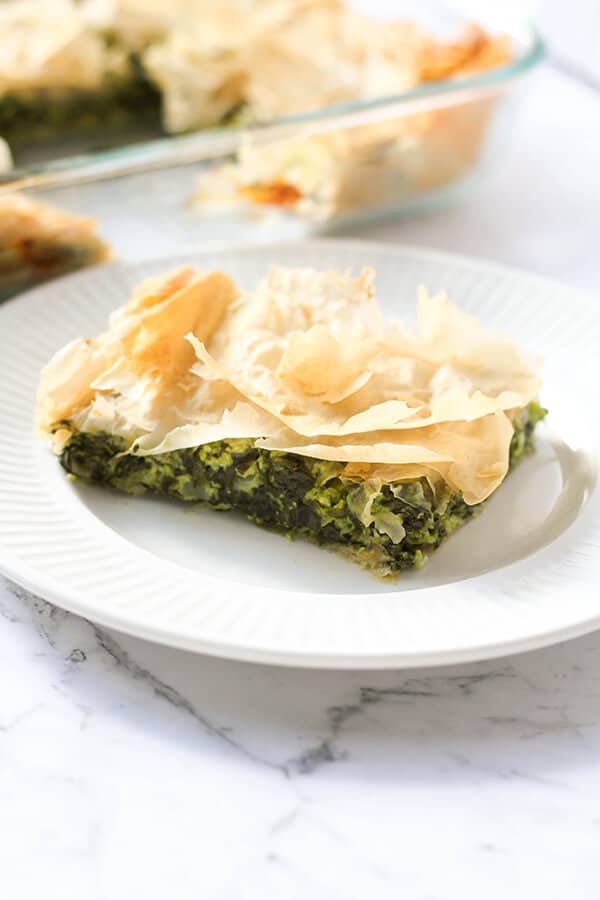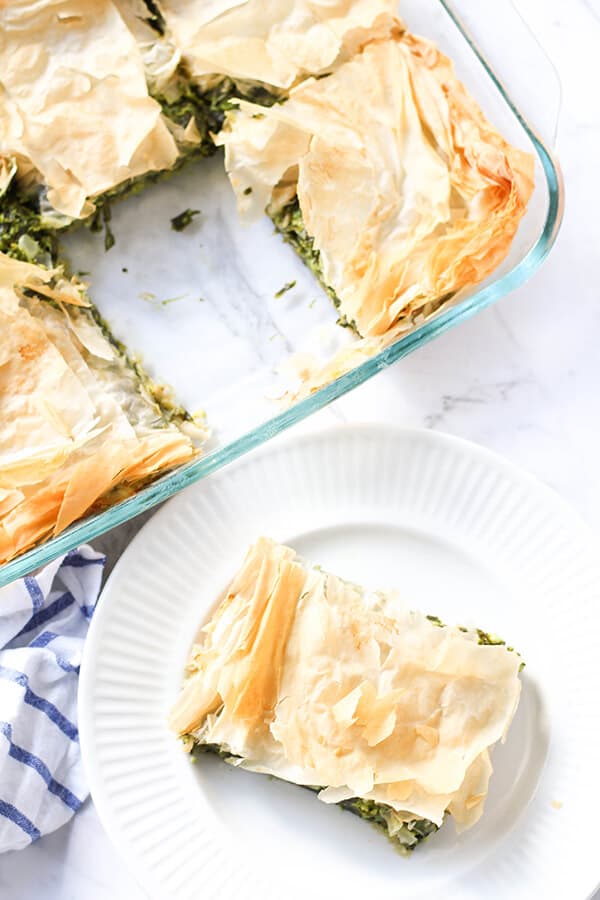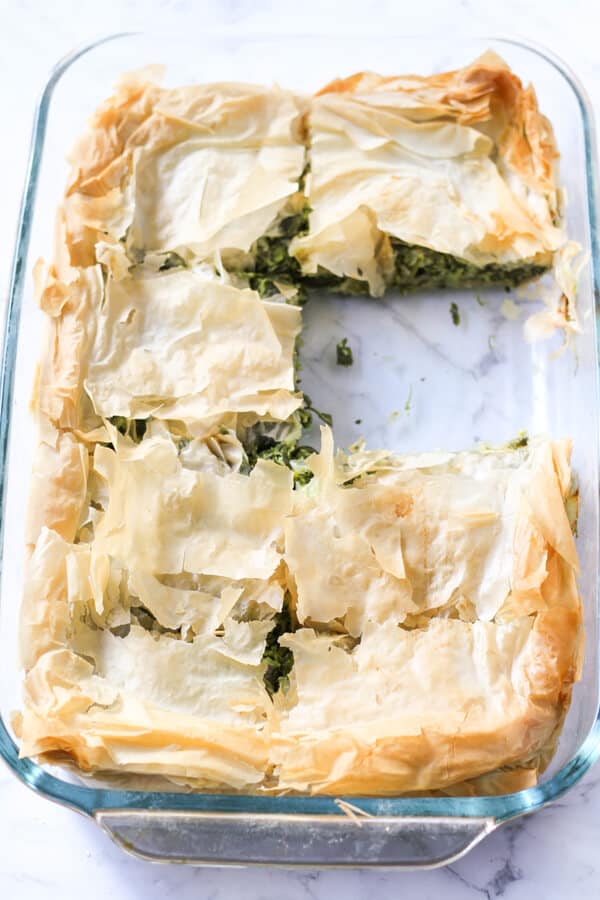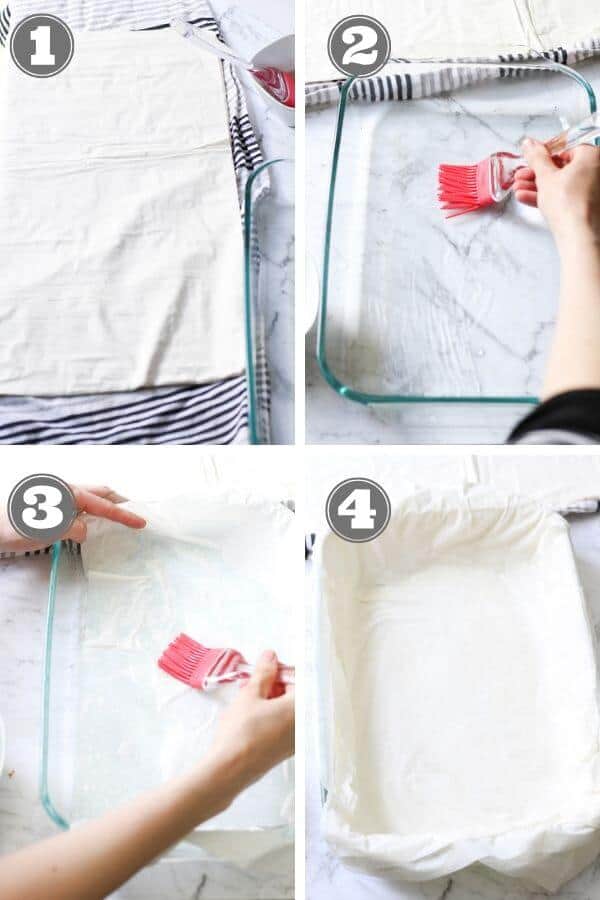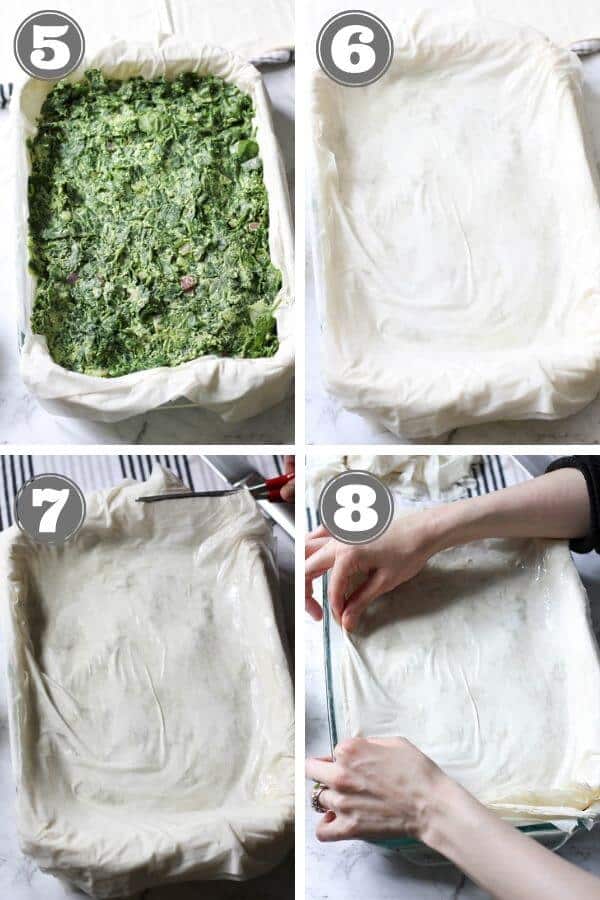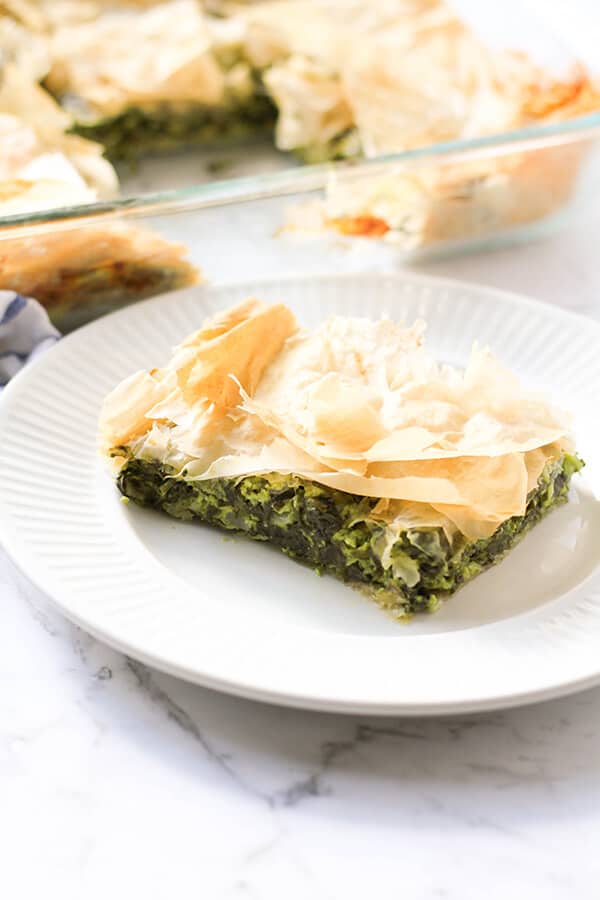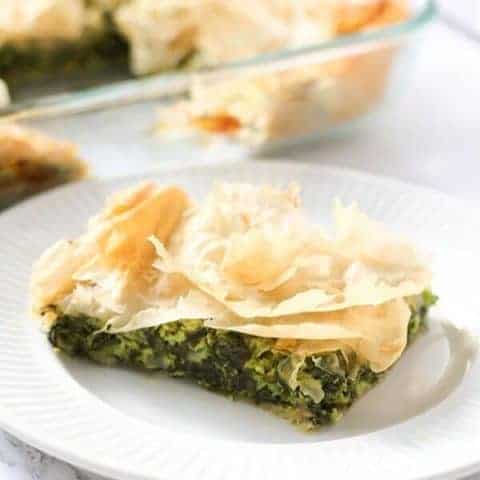Spanakopita (span-a-kop-ita) is a delicious and authentic Greek Spinach Pie. There’s probably not a more classic Greek pairing then spinach and feta - and they well and truly shine in this dish. You’ll find Spanakopita on the menu at any self respecting Greek restaurant, but nowadays you are also just as likely to find at your local cafe. If you have yet to try it, you’re in for a treat!
WHAT IS SPANAKOPITA?
Spanakopita is essentially a Greek version of a cheesy spinach pie. If you’ve ever had the combination of spinach and cheese with pastry (spinach ricotta rolls, triangles etc), this is pretty close to that.
TIPS FOR MAKING SPANAKOPITA
The Spinach
You can choose your own adventure when it comes to spinach. Bunches of English spinach, boxes of frozen spinach or bags of fresh spinach leaves all work. For frozen spinach, thaw completely and drain as much water as possible. For English spinach - wash well, remove the stems and chop roughly. For bagged fresh spinach - wash well and chop roughly. Although some recipes suggest it, I don’t cook the spinach first. I find it gets ample time in the oven to cook and this is just an unnecessary step.
The Cheese
Most traditional recipes only use feta. Some use feta and ricotta. I find the pie lacks a little something when it’s flavoured with one cheese, plus I love my cheese, so I use 3 - feta, ricotta and parmesan. You can sub parmesan cheese for another hard cheese - pecorino, kefalograviera etc. Or omit completely and just add a little more feta.
The Flavourings
The overwhelming majority of traditional recipes contain dill. Some also had parsley. I stuck with dill as I a) hate buying a bunch of fresh herbs for one recipe and b) I don’t find the spanakopita lacking without parsley. Traditional recipes also call for a pinch of grated nutmeg. As these aren’t readily available in most supermarkets (sure, the dried kind is on hand but not fresh), I omitted. If you find some, put it in.
The Pastry
Filo pastry (also spelled Phyllo) is a dough that is made into paper thin sheets. It becomes flaky and golden when cooked. For this recipe I recommend using fresh filo pastry (from the fridge aisle) and leaving it to thaw to room temperature (at least 2 hours) before using. When you’re not using the filo, sandwich it between two damp (not wet!) tea towels to stop it from drying out. Filo pastry will tear as you work with it - don’t stress. We layer it on so no one piece makes all the difference. Just try and use a few intact pieces for the top and you’ll be right. I’d also say here that it’s easier to cut your pastry before you bake the spanakopita - I accidentally popped my in the oven without it and although you can cut still cut it, flaked pastry flies everywhere! If you’re a stickler for presentation, go ahead and cut before you bake.
The Shape
If you’ve been to a Greek restaurant (or even Greece) you’ve probably seen Spanakopita in many forms. A whole pie, a spiral shape or even individual triangles. You can make your spanakopita into any shape you desire. I choose pie because I find it’s easier. The instructions for how to do this are in the recipe instructions below, but I thought I’d explain the other two methods in case you decide to go down this route. To make a spiral shape: Lay a sheet of filo pastry on a flat surface (longest side facing you) and brush with olive oil. Lay a second sheet on top of the first sheet and brush with oil. Spread some filling to cover the longest side of the pastry, then roll into a ‘sausage’ shape. Roll into a spiral (or a ‘snail’ shape) and place into the centre of a round baking dish or baking tray. Repeat this process twice more, rolling each new one around the other to make your spiral longer. To make individual triangles: Lay a sheet of filo pastry on a flat surface (longest side facing you) and brush with olive oil. Lay a second sheet on top of the first sheet and brush with oil. Cut your filo into 3 or 4 long strips. Place some filling in the bottom right of one strip, then bring over the left corner of the dough to enclose the filling and form a triangle. Continuing folding over and over again, using the whole strip. Repeat to use up the rest of your ingredients.
HOW TO MAKE SPANAKOPITA - STEP BY STEP
If using fresh spinach - wash, trim the roots and roughly chop. Place in colander, salt and leave for 10 or so minutes to wilt. Squeeze out as much water as possible. If using frozen spinach - simply allow to thaw & squeeze out as much water as possible. Place feta in a large mixing bowl and mash with a fork to break it up. Add ricotta, parmesan, shallots, red onions, eggs, garlic, breadcrumbs, pepper and dill and mix to combine. Add spinach to the bowl and use your hands to mix well. Lay filo pastry sheets on a damp tea towel (photo 1). Lightly brush a rectangular baking dish (20cm x 30cm x 5cm / 9in x 13in x 2.5in ) with oil (photo 2). Place a sheet of filo into the baking dish and brush with oil (photo 3). Continue, overlapping filo pastry sheets, until you’ve got 6 sheets - making sure to brush each filo sheet with oil as you go. Leave any excess hanging over the sides (photo 4).
Pour the filling over the filo sheets, levelling the top (photo 5), then repeat the filo sheet layering process so that there’s 6 layers on top (photo 6). Make sure the top of the pastry is thoroughly brushed with oil. Trim any excess pastry with some scissors (photo 7), then tuck what remains down the sides of the baking dish (photo 8). Use a sharp knife to score the pastry into your desired portions (squares, rectangles, diamonds), then place in the oven for 45-50 minutes, until well browned. The pie should also slide easily if you gently shake your baking dish. Allow to cool for 15 minutes before slicing, then serve.
CAN SPANAKOPITA BE MADE IN ADVANCE?
If you’re planning to serve spanakopita at a family get together and want to make it advance, simply prep your spanakopita the night before and leave uncooked until the next day. Store in an airtight container (my baking dish has a lid) or cover tightly with cling film and store in the fridge until you’re ready to cook.
STORING SPANAKOPITA
Leftover spanakopita can be kept in the fridge for 2-3 days. Reheat in the oven (180C / 350F) for 10 minutes or until warmed through. I don’t recommend microwaving as this will make the pastry soggy. You can also freeze portions of spanakopita and reheat in the same fashion (just for a little longer) - no need to thaw in advance.
WHAT TO SERVE WITH SPANAKOPITA?
Spanakopita can be served on it’s own, or pair it with these classic Greek dishes:
Easy Greek Salad Greek Lemon Potatoes Greek Tzatziki
MORE GREEK RECIPES
Greek Chicken and Potatoes How to Cook Halloumi Kolokithokeftedes (Greek Zucchini Fritters) Chicken Gyros OR see all Greek Recipes
If you’ve tried this Spanakopita I’d love to hear how you enjoyed them! Pop a comment and a star rating below! You can also FOLLOW ME on FACEBOOK, INSTAGRAM and PINTEREST to keep up to date with more delicious recipes. SPINACH
Choose your own adventure with spinach - frozen, fresh bagged or english spinach is all fine.
CHEESE
I encourage you to get Greek cheeses for this recipe. Greek Feta in particular is better than others in this recipe. I used feta and ricotta from Olympus Cheese and I loved the flavour.
MAKE AHEAD
You can make this the night before (without baking). Wrap in cling film and store in fridge until you’re ready to bake.
STORING
Store in an airtight container in the fridge for 2-3 days, or in the freezer for 1 month. Reheat in the oven until warmed through - don’t microwave, as the pastry goes soggy.
NUTRITION
Nutrition information is from a nutrition calculator and is for one serve.
